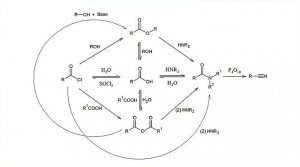Playlist
Show Playlist
Hide Playlist
Exercise – Carboxylic Acids and Their Derivatives
-
Slides 08 Chemistry Advanced Le Gresley.pdf
-
Download Lecture Overview
00:01 Now, what I’d like you to do is have a look at the following reactions, for the synthesis of amides. If you recall, I said right at the very beginning of this particular lecture set, was that you can’t react a carboxylic acid directly with an amine; it’s very difficult to do, not impossible, but very difficult. And so, the reaction A, shown above, is something that under normal laboratory conditions would not take place. 00:26 If we look at the third example, this is where we are converting an amide into an ester, and I bring you back to a slide which was only three slides ago, it is very difficult without a particular activation from a biological component to convert an amide back into an ester. And so, this reaction is also not possible under standard reaction conditions. 00:49 However, B, this is possible. We have already said that an acid chloride can react with an alcohol to generate an ester and this is because the leaving group is a good one and also an alcohol is a good enough nucleophile to achieve this. In both of the other cases, either the leaving group isn’t good enough or the nucleophile itself isn’t strong enough. 01:11 Based on your newfound understanding of how substitution on a carboxylic acid can influence acidity, the strength of an acid, what I would like you to now do is to look at the following structures numbered 1, 2, 3, 4 and 5 and put them in correct order of decreasing strength of acidity. 01:32 Now, as you can see here, the numbers in green show the order in terms of strength of acidity 4, 2, 3, 5 and 1. So, in other words, this is telling us that the strongest acid is the difluoroacetic acid or ethanoic acid and this makes a lot of sense because we have two highly electronegative atoms attached in the alpha position or the 2 position on our ethanoic acid. So, this serves to stablise the carboxylate anion more than, indeed, any other type that we see here in front of us. 02:10 The second one is the monofluoro, bearing in mind, of course, a fluorine is more electronegative than either a bromine or a chlorine. Again, it is still in the alpha position followed by 3, which is the next alpha or 2 position substituted acetic or ethanoic acid, where we have a bromine. Bromine is also more electronegative than carbon, pulling electron density away, although not nearly as well as a fluorine. This serves to stablise the carboxylate and therefore, makes this relatively acidic. 02:41 In the case of 5, we have acetic or ethanoic acids and of course, this, therefore, having no substituents on it, is not going to be the most acidic and it falls in position 5. 02:53 And finally, if we look at compound 1, we can see that it’s a propanoic acid therefore, because we have three carbons in a row: 1, 2 and 3. And you could look at it in that way, but you could also look at it as an ethanoic acid which is substituted by a methyl group in its 2 position. 03:11 As we have said before, in the case of halogens, they are electronegative, they pull electron density away, stabilising a carboxylate. In the case of our methyl group though, it is a positive inductive effect, donating electrons, which in the case of generating a carboxylate from the dissociation in this acid, would destabilise the resulting conjugate base. 03:31 Therefore, propanoic acid, because of this electron donation, is the weakest acid out…
About the Lecture
The lecture Exercise – Carboxylic Acids and Their Derivatives by Adam Le Gresley, PhD is from the course Organic Chemistry.
Included Quiz Questions
Which of the following is the weakest acid?
- CH3CH2COOH
- CH3COOH
- FCH2COOH
- C6H5CH2COOH
- F2CHCOOH
Which of the following reactions is correct?
- CH3OH + CH3COOH → CH3COOCH3 + H2O
- CH3COCl + NH3 → CH3CONH3
- CH3OH + CH3COOH → CH3COCH3 + H2O
- CH3COOH + NH3 → CH3CONH2 + H2O
Customer reviews
5,0 of 5 stars
| 5 Stars |
|
5 |
| 4 Stars |
|
0 |
| 3 Stars |
|
0 |
| 2 Stars |
|
0 |
| 1 Star |
|
0 |




